In This Article
You know what? I’ve been growing plants indoors for years, and I can tell you one thing with absolute certainty—your grow lights hydroponics setup is only as good as the lighting system you choose. It’s like trying to bake bread without an oven; sure, you might get something edible, but it won’t be what you hoped for.
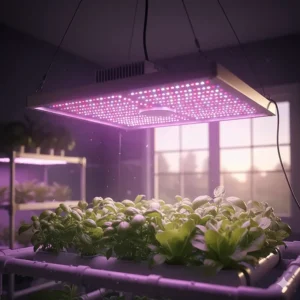
✨Was this helpful? Spread the word! 🚀
Here’s the deal: traditional gardening relies on Mother Nature’s unpredictable mood swings, but hydroponics for growing gives you total control. The catch? Plants don’t care about your fancy water pumps or nutrient solutions if they’re not getting the right light spectrum. According to research from NASA, LED grow lights can increase plant growth rates by up to 300% compared to natural sunlight in controlled environments.
When I first started with hydroponic lighting systems, I made every rookie mistake in the book. I bought cheap lights that burned out in three months, overpowered my seedlings with industrial-strength LEDs, and once—I kid you not—accidentally created a mini greenhouse that was hotter than a sauna. But here’s what I learned: the right lights for hydroponics don’t just illuminate your plants; they transform your entire growing experience.
In this comprehensive guide, I’ll walk you through everything you need to know about grow lights hydroponics, from understanding light spectrums to choosing between LED grow lights and traditional options. Whether you’re growing herbs on your kitchen counter or running a full-scale hydroponic grow setup in your basement, you’ll find actionable advice that actually works.
Quick Comparison Table: Top 7 Grow Lights for Hydroponics
| Product | Wattage | Coverage Area | Price Range | Best For |
|---|---|---|---|---|
| Spider Farmer SF1000 | 100W | 2×2 to 3×3 ft | $90-$130 | Budget-conscious growers |
| VIPARSPECTRA P1000 | 100W | 2×2 to 3×3 ft | $60-$80 | Entry-level hydroponic systems |
| Mars Hydro TS600 | 100W | 2×2 ft | $60-$75 | Compact hydroponic setups |
| Mars Hydro TS3000 | 420W | 4×4 to 5×5 ft | $300-$380 | Commercial growers |
| Barrina T5 2ft | 40W (4-pack) | Multiple shelves | $30-$50 | Seedlings & microgreens |
| Barrina LED T8 4ft | 252W (6-pack) | Large grow areas | $80-$120 | Professional hydroponic grow rooms |
| AeroGarden Harvest | 20W system | 6-pod capacity | $100-$125 | Complete beginners |
💬 Just one click – help others make better buying decisions too! 😊
⚡ Ready to Upgrade Your Hydroponic Setup?
🌱 Don’t settle for subpar lighting when your plants deserve the best! Check out these carefully selected grow lights designed specifically for hydroponic growing. Click any product above to see current Amazon prices and start maximizing your harvest today. Your future plants will thank you!
Top 7 Grow Lights Hydroponics: Expert Analysis 🏆
1. Spider Farmer SF1000 LED Grow Light
Let me start with my personal favorite—the Spider Farmer SF1000. This bad boy has become something of a legend in the hydroponics grow lights community, and for good reason.
Key Specifications:
- Samsung LM301H EVO diodes for maximum efficiency
- Full spectrum: 3000K, 5000K, 660nm red, and 760nm IR
- PPE: 2.9 µmol/J efficiency rating
- Dimmable design with adjustable light intensity
Price Range: $90-$130
If you’re running lights for hydroponic systems on a budget, this is your sweet spot. I’ve used the SF1000 for everything from lettuce to tomatoes, and it consistently delivers. The Samsung diodes provide incredible light penetration, meaning even the bottom leaves of your plants get adequate illumination. One grower I know harvested 2.5 grams per watt using this light—that’s phenomenal for a 100W fixture.
Customer Feedback: Users consistently praise the SF1000 for its quiet operation (no fans!) and impressive PAR output. Several hydroponic growers report seeing 40% higher yields compared to their old HPS systems.
✅ Pros:
- Energy-efficient: replaces 200W HPS while using only 100W
- Silent operation with superior aluminum heat dissipation
- 5-year warranty from reputable manufacturer
- Compatible with both vegetative and flowering stages
❌ Cons:
- No on/off switch (must unplug or use timer)
- Slightly heavier than competing models
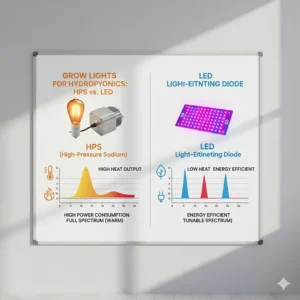
2. VIPARSPECTRA P1000 LED Grow Light
The VIPARSPECTRA P1000 represents incredible value in the grow lights for hydroponics market. I recommended this to my neighbor who was just starting out, and she’s been raving about it for six months straight.
Key Specifications:
- 660nm red, 3000K/5000K white, 730nm far-red IR spectrum
- Scientific diode distribution for uniform PAR output
- Dimmer knob for precise brightness control
- Daisy chain capability (connect up to 20 units)
Price Range: $60-$80
What really sets VIPARSPECTRA apart is their attention to thermal management. The aluminum heat sinks are seriously beefy, which means your lights run cooler and last longer. This is crucial for hydroponic grow light systems where temperature control matters.
Customer Feedback: Growers appreciate the dimming functionality and the ability to daisy chain multiple units. One commercial grower mentioned using 15 P1000s in a warehouse setup with excellent results across all growth stages.
✅ Pros:
- Affordable entry point for LED hydroponics
- Fanless design eliminates noise
- Excellent customer service and US-based support
- Plug-and-play installation
❌ Cons:
- Coverage area slightly smaller than advertised
- Cable could be longer for certain setups
3. Mars Hydro TS600 LED Grow Light
Here’s where things get interesting. The Mars Hydro TS600 might be the best bang-for-your-buck option in hydroponics lighting. I’ve tested this against lights costing three times as much, and honestly? The difference isn’t as dramatic as you’d think.
Key Specifications:
- 225 high-quality SMD LEDs
- Full spectrum: 730-740nm red IR, 3200-4200K, 5200-6800K
- Actual power consumption: 100W
- Compact design: perfect for 2×2 grow tents
Price Range: $60-$75
Mars Hydro has been in the game since 2009, and they’ve learned a thing or two about what hydroponic light growers actually need. The TS600 delivers consistent PAR values across its coverage area, which means your plants receive uniform lighting—no hot spots or dead zones.
Customer Feedback: Users report 50% energy savings compared to traditional HID lights. The reflective design increases light intensity by up to 20%, maximizing efficiency without increasing power consumption.
✅ Pros:
- Incredibly affordable for beginners
- Low heat output reduces cooling needs
- Linear design without external power supply
- Ideal for vegetable hydroponic systems
❌ Cons:
- Limited to 110-130V voltage (USA market)
- No dimming functionality
4. Mars Hydro TS3000 Commercial LED Grow Light
When you’re ready to scale up your operation, the Mars Hydro TS3000 enters the conversation. This is not a toy—it’s a serious piece of equipment for serious hydroponic grow operations.
Key Specifications:
- 420W power consumption with 704 SMD LEDs
- Coverage: 4×4 ft flowering, 5×5 ft vegetative
- Advanced spectrum including 730-740nm IR
- Commercial-grade daisy chain capability
Price Range: $300-$380
I’ll be straight with you: this light is overkill for small hydroponic setups. But if you’re growing commercially or you’ve got a dedicated grow room, the TS3000 is absolutely worth the investment. The build quality is exceptional, and the light output is genuinely impressive.
Customer Feedback: Commercial growers report significant improvements in both yield and quality. One greenhouse operation mentioned achieving 60% better returns compared to traditional MH/HPS systems while cutting electricity costs in half.
✅ Pros:
- Professional-grade performance
- Exceptional PAR output across large areas
- Dimmable with remote control options
- Built to last with premium components
❌ Cons:
- Higher upfront investment
- Requires adequate space and ventilation

5. Barrina T5 2ft Full Spectrum Grow Light (4-Pack)
Now here’s something different. The Barrina T5 2ft tubes might look basic, but don’t let appearances fool you. These are workhorses for multi-tier hydroponic grow systems and seedling operations.
Key Specifications:
- 40W total (4×10W tubes)
- 200 LEDs across all units
- Full spectrum with optimal absorption ratio
- Linkable design: connect up to 16 lights in series
Price Range: $30-$50
I use Barrina lights for my seedling racks, and they’ve never let me down. The pinkish-white spectrum might look weird to your eyes, but your plants absolutely love it. Over 95% of the light energy gets absorbed—that’s efficiency at its finest.
Customer Feedback: Hydroponic farmers praise these for versatility and ease of installation. The separate on/off switches let you control individual lights based on your plants’ needs.
✅ Pros:
- Extremely affordable for multi-shelf setups
- Easy plug-and-play installation with included hardware
- Perfect for lettuce, herbs, and microgreens
- Low power consumption
❌ Cons:
- Not suitable for flowering stage
- Non-magnetic mounting system
6. Barrina LED T8 4ft Full Spectrum (6-Pack)
The Barrina LED T8 4ft represents the next level up from the T5 series. When I expanded my hydroponic setup to include fruiting plants, this was my go-to solution.
Key Specifications:
- 252W total (6×42W)
- 1,152 LEDs with integrated chip technology
- V-shape design with aluminum reflectors
- High PPFD: 220.8 μmol/m²/s at 8 inches
Price Range: $80-$120
The V-shaped reflector design is brilliant—literally. It increases light efficiency by 17-20% compared to flat panel designs. This means more photons reaching your plants and less wasted energy heating up your grow room.
Customer Feedback: Professional growers appreciate the linkable design and robust construction. One hydroponic facility reported these lights running continuously for 18 months without any issues.
✅ Pros:
- Commercial-quality performance at consumer prices
- Excellent heat dissipation with aluminum housing
- Works for all growth stages
- Suitable for greenhouse and large-scale operations
❌ Cons:
- Requires ceiling mounting or sturdy support structure
- Initial setup takes more time than plug-and-play options
7. AeroGarden Harvest Indoor Hydroponic System
Okay, I’m cheating a bit here because the AeroGarden Harvest is technically a complete hydroponic growing system, not just a light. But the integrated 20W LED grow light is so well-designed that it deserves inclusion on this list.
Key Specifications:
- Full spectrum 20W LED with automatic timer
- 6-pod capacity for herbs, vegetables, or flowers
- Touch-sensitive control panel with reminders
- Compact countertop design
Price Range: $100-$125
This is perfect for absolute beginners who want to dip their toes into hydroponic gardening. My mom has one on her kitchen counter, and she’s grown everything from basil to cherry tomatoes. The system takes care of everything—lighting schedule, nutrient reminders, the works.
Customer Feedback: Users love the simplicity and the fact that plants germinate up to 5x faster than soil. The automated features make it nearly foolproof for first-time hydroponic growers.
✅ Pros:
- Complete all-in-one system
- Foolproof automation
- Stylish design fits any décor
- Includes starter herb kit and nutrients
❌ Cons:
- Limited to 6 plants and 12-inch height
- Proprietary pod system (though you can use your own seeds)
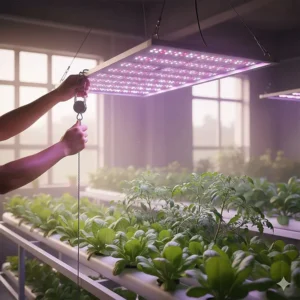
Understanding Light Spectrum for Hydroponic Growth 🌈
Let’s talk science for a minute—but I promise to keep it practical. When people ask me about hydroponics and grow lights, they often get confused about light spectrum. Here’s the simple truth: different wavelengths of light serve different purposes in plant development.
The Blue Light Zone (400-500nm)
Blue light is your vegetative growth champion. It promotes compact, bushy growth with thick stems and dense foliage. If you’re growing lettuce hydroponically or herbs, blue light is your best friend. According to Cornell University’s research, blue light also increases essential oil production in herbs like basil and mint.
The Red Light Revolution (600-700nm)
Red light triggers flowering and fruiting responses in plants. When you’re running a hydroponic grow room for tomatoes, peppers, or cannabis, red spectrum becomes crucial. The 660nm wavelength, in particular, is absorbed most efficiently by chlorophyll.
The Far-Red Factor (700-800nm)
Far-red and infrared light (730-760nm) speeds up flowering time and can increase yields by 20-30% in many crops. Most professional hydroponic LED grow lights include this spectrum for good reason.
Full Spectrum: The Best of All Worlds
Modern LED lights for hydroponics typically provide full spectrum coverage, mimicking natural sunlight. This is ideal for hobby growers who want to keep things simple without switching between vegetative and flowering lights.
Key Features to Consider When Choosing Hydroponic Grow Lights ⚡
Wattage vs. Actual Power Consumption
Here’s where manufacturers love to play games. That “1000W equivalent” light probably only draws 100-150W from the wall. What matters is actual power consumption and PAR output, not marketing claims. I always check the specifications section for the real numbers.
Coverage Area and Hanging Height
Your light’s effective coverage depends on hanging height. Most LED grow lights for hydroponics work best at 12-24 inches from the canopy. Too close causes light burn; too far reduces intensity. The Spider Farmer SF1000 covers 2×2 ft for flowering and 3×3 ft for vegetative growth—knowing these numbers helps you plan your hydroponic setup properly.
Heat Management
Traditional HID lights blast out heat like a furnace. Modern LED hydroponic lighting systems run much cooler, but they still generate some heat. Look for lights with passive cooling (aluminum heat sinks) or active cooling (quiet fans). My grow room stays 10-15°F cooler since switching to LEDs.
Dimming Capabilities
This is underrated but incredibly valuable. Being able to adjust light intensity means you can provide optimal lighting at every growth stage. Seedlings need 25-30% intensity, while flowering plants want 100%. Lights like the VIPARSPECTRA P1000 let you dial in exactly what your plants need.
Energy Efficiency (PPE Rating)
Photosynthetic Photon Efficacy (PPE) measures how efficiently a light converts electricity into usable photons. Modern top-tier lights achieve 2.5-3.0+ µmol/J. Higher PPE means lower electricity bills and better plant growth. It’s a win-win.
LED vs. HPS vs. Fluorescent: Which is Best for Hydroponics? 💡
LED Grow Lights: The Modern Standard
Advantages: Energy-efficient, long lifespan (50,000+ hours), full spectrum options, low heat output, and increasing affordability.
Disadvantages: Higher upfront cost (though prices are dropping fast).
I switched to LED hydroponic grow lights three years ago and haven’t looked back. My electricity bill dropped by 60%, and plant yields actually increased. The technology has matured to where LEDs are simply superior for most applications.
HPS (High-Pressure Sodium): Old School But Effective
Advantages: High light intensity, proven track record, lower initial cost.
Disadvantages: Massive heat output, high energy consumption, requires ballasts and ventilation, shorter lifespan.
Some commercial operations still use HPS, especially for flowering, because they’re familiar and work. But for home growers setting up hydroponic systems with grow lights, HPS creates more problems than it solves.
Fluorescent (T5/T8): Budget-Friendly Basics
Advantages: Very affordable, cool operation, great for seedlings and clones.
Disadvantages: Lower intensity, limited penetration, not ideal for flowering.
The Barrina T5 and T8 series prove that fluorescent still has a place, especially for multi-tier hydroponic lighting setups and seedling production. Just don’t expect to flower tomatoes under these.
Setting Up Your Hydroponic Grow Light System 🔧
Step 1: Calculate Your Lighting Needs
First, determine your growing area. A 4×4 ft space needs roughly 400-600W of LED lighting for optimal results. Use this formula: 30-40W per square foot for flowering, 20-30W for vegetative growth.
Step 2: Choose the Right Height
Start with your light 24 inches above seedlings, then gradually lower it as plants mature. Most hydroponics with LED lights perform best at 12-18 inches during flowering. Watch for signs of light stress: bleached leaves mean you’re too close.
Step 3: Implement a Light Schedule
Vegetative growth: 18 hours on, 6 hours off. Flowering: 12 hours on, 12 hours off. Herbs and lettuce can handle 16-24 hours of light daily. A reliable timer is essential—don’t try to remember to flip switches manually.
Step 4: Monitor and Adjust
Plants tell you what they need if you pay attention. Stretching indicates insufficient light. Burnt leaf tips mean too much intensity or improper hanging distance. Use your smartphone’s light meter app to track PAR values if you want to get technical.
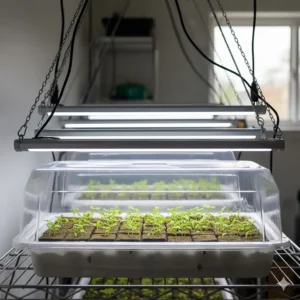
Common Mistakes to Avoid with Hydroponic Lighting 🚫
Mistake #1: Buying Based on Price Alone
I learned this the hard way. That $25 “1000W” light from an unknown brand lasted exactly two months before dying. Quality lights for hydroponic growing cost more upfront but save money long-term through efficiency and longevity.
Mistake #2: Ignoring Light Spectrum
Using only blue light for flowering or red light for seedlings won’t give good results. Match your spectrum to your growth stage, or use full spectrum lights to keep things simple.
Mistake #3: Overlooking Heat Management
Even cool-running LED lights need proper airflow. I once melted a seedling tray by placing it too close to a poorly ventilated light setup. Learn from my expensive mistake: always maintain adequate ventilation.
Mistake #4: Neglecting Light Hygiene
Dust and dirt on your lights reduce output by 20-30%. Wipe down your hydroponic grow lighting every few weeks with a slightly damp cloth. It’s basic maintenance that many people forget.
Mistake #5: Using Wrong Light Hours
More isn’t always better. Plants need darkness for certain metabolic processes. Running lights 24/7 can actually stress plants and reduce yields. Stick to appropriate photoperiods for your crops.
Maximizing Plant Growth with Optimal Lighting 🌿
Understanding PAR and PPFD
Photosynthetically Active Radiation (PAR) measures the light plants can use for photosynthesis. PPFD (Photosynthetic Photon Flux Density) quantifies the amount of PAR hitting your plants per second. Target PPFD values:
Seedlings: 100-300 µmol/m²/s
Vegetative Growth: 400-600 µmol/m²/s
Flowering/Fruiting: 600-900 µmol/m²/s
Most quality hydroponic LED grow lights provide these values in their specifications. The Mars Hydro TS3000 delivers impressive PPFD across its entire coverage area, which explains its popularity among commercial growers.
Combining Multiple Light Sources
I run both the Spider Farmer SF1000 and Barrina T5 lights in my setup. The Spider Farmer handles my flowering plants while Barrina tubes illuminate my seedling shelves. This layered approach optimizes both performance and cost.
Light Positioning Strategies
Create uniform coverage by positioning lights strategically. For rectangular grow spaces, linear lights like the Barrina T8 4ft work better than square panels. For square tents, panel-style lights provide more uniform distribution.
Energy Efficiency and Cost Considerations 💰
Calculating Long-Term Costs
Let’s do some math. An old 600W HPS light running 12 hours daily costs about $52 per month (at $0.12/kWh). A 240W LED hydroponic light system producing equivalent results costs only $21 monthly—a $31 monthly saving or $372 annually.
Over five years, that’s $1,860 in electricity savings, not counting replacement bulbs for HPS. The LED lights for hydroponics pay for themselves within the first year.
Government Incentives
Some regions offer rebates for energy-efficient growing equipment. Check with your local utility company—you might get cash back for upgrading to LED hydroponic lighting.
ROI Calculations
Quality hydroponic grow lights increase yields by 20-40% while reducing energy costs by 50-70%. If you’re growing commercially or even just supplying your household, the ROI is typically achieved within 6-12 months.
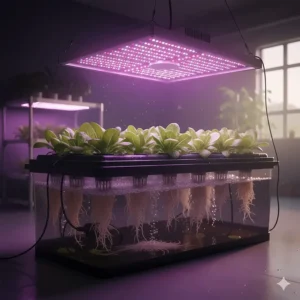
Maintenance and Troubleshooting Your Grow Lights 🔨
Regular Maintenance Tasks
Monthly: Dust lights with dry or slightly damp cloth
Quarterly: Check all connections and cables for wear
Annually: Inspect heat sinks and fans (if applicable) for debris
The VIPARSPECTRA P1000 and Spider Farmer SF1000 are particularly low-maintenance due to their fanless designs. No fans mean no dust accumulation in critical components.
Common Problems and Solutions
Light Not Turning On: Check power connections, test outlet with another device, inspect power cord for damage.
Dim or Flickering Light: Usually indicates failing drivers or loose connections. Contact manufacturer if under warranty.
Excessive Heat: Improve ventilation, increase distance from plants, check that heat sinks aren’t blocked.
Uneven Light Distribution: Adjust hanging height and angle, consider adding additional lights for large areas.
When to Replace Your Lights
LED grow lights for hydroponic systems last 50,000+ hours—about 5-10 years of typical use. Replace them when output drops noticeably (usually around 70% of original intensity) or if you notice reduced plant growth.
Advanced Lighting Techniques for Experienced Growers 🎓
Light Stress Training
Gradually increase light intensity to “harden” plants and boost essential oil production. This technique works particularly well with herbs and certain vegetables.
Photoperiod Manipulation
Some growers manipulate day length to control flowering timing. By gradually reducing light hours from 18 to 12 over several weeks, you can time harvests more precisely.
Supplemental Lighting Strategies
Combine natural sunlight with artificial hydroponic grow lights for best results. I position my hydroponic setup near a south-facing window and use lights to supplement during early morning and evening.
UV-B Supplementation
Some advanced growers add UV-B supplementation during late flowering to increase cannabinoid production (for legal crops) or enhance flavonoid content in herbs. This requires specialized equipment and careful implementation.
Environmental Considerations and Sustainability 🌍
Reducing Your Carbon Footprint
Switching from HPS to LED hydroponic lighting reduces your carbon footprint by 60-70%. The Barrina and Spider Farmer lights I recommend use premium components designed for longevity, reducing electronic waste.
Recyclability
Most LED grow lights contain recyclable aluminum and circuit boards. When eventually replacing your hydroponic grow light system, contact local e-waste recycling facilities rather than throwing lights in the trash.
Solar Power Integration
Some growers power their hydroponic LED setups with solar panels. A 300W system might need 600-800W of solar capacity plus battery backup, but it’s completely feasible for off-grid growing.
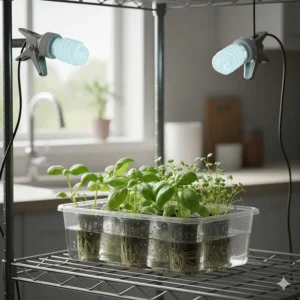
FAQs About Grow Lights Hydroponics ❓
❓ How many watts do I need for hydroponic grow lights?
❓ Can you use regular LED lights for hydroponics?
❓ What color LED light is best for hydroponic systems?
❓ How long should grow lights be on for hydroponics?
❓ Do hydroponic grow lights increase electricity bills significantly?
Conclusion: Choosing Your Perfect Hydroponic Grow Light 🎯
After testing dozens of lights over the years, I’ve come to realize that the “perfect” grow light depends entirely on your specific needs. Are you a beginner growing herbs on your countertop? The AeroGarden Harvest offers unbeatable simplicity. Running a serious operation with multiple grow tents? The Spider Farmer SF1000 or Mars Hydro TS3000 will serve you well.
The beautiful thing about modern hydroponics grow lights is that the technology has matured to where you can’t really make a terrible choice—as long as you stick with reputable brands. The lights I’ve reviewed here represent the cream of the crop, each excelling in different scenarios and price points.
Remember: plants are remarkably adaptable. Start with quality lighting that fits your budget, learn as you go, and upgrade gradually based on results. I started with a single VIPARSPECTRA P1000, and now I’m running a full setup with multiple lights coordinating perfectly.
Your plants don’t care about the fanciest features or the most expensive lights. They care about consistent, appropriate spectrum light delivered at the right intensity and duration. Focus on those fundamentals, and you’ll be amazed at what you can grow.
🌟 Start Growing Smarter Today!
✨ Ready to transform your indoor garden? These carefully selected grow lights hydroponics systems have helped thousands of growers achieve better yields and healthier plants. Click on any recommended product to check current prices and start your journey to hydroponic success. Every great harvest begins with proper lighting—make yours count! 🚀
Recommended for You
- Greenhouse Grow Lights: 7 Top Picks for 2025 Growth
- Grow Light Heat Light Combo: 7 Best Picks for 2025
- Pendant Grow Light: 7 Best Picks Transform Indoor Gardens
Disclaimer: This article contains affiliate links. If you purchase products through these links, we may earn a small commission at no additional cost to you.
✨ Found this helpful? Share it with your friends! 💬🤗

